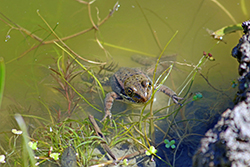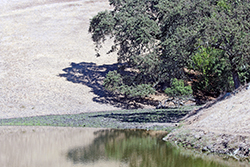
A California red-legged frog sits motionless at the edge of McClure pond at the Sparling Ranch Conservation Bank. Photo by Ashley Spratt/USFWS

McClure pond is one of the most productive California red-legged frog ponds at the Sparling Ranch Conservation Bank. Like many of those on Sparling Ranch, it was named after the family who homesteaded in site in the late 1800s. Photo by Ashley Spratt/USFWS
Since the mid-1980s, California has been using a system of conservation and mitigation banking to protect valuable natural resources and critical habitat for fish, wildlife and plants. These banks are generally large, connected, ecologically meaningful areas of preserved, restored, enhanced or constructed habitat (for example, wetlands) that are set aside for the express purpose of providing mitigation for project impacts. Conservation banks provide mitigation for impacts to listed species and habitats, while wetland mitigation banks primarily provide mitigation for wetland impacts. Together, they serve to prevent inadequate, fragmented reserves that can result when mitigation projects are carried out individually.
Banks work by establishing credits for sensitive species or habitats found on a given site. These credits can then be sold to developers or other project proponents who need to meet permitting requirements or are otherwise required to compensate for environmental impacts. For those parties needing to mitigate for project impacts, banks serve to streamline the regulatory process by providing a pre-established mitigation site that the regulating state and federal agencies have already confirmed will provide adequate and appropriate mitigation for certain habitats or species. By mitigating at a bank, project proponents can avoid the time and cost of searching for a suitable mitigation site and protecting it in perpetuity themselves.
In order for the banking system to be effective, state and federal agencies must work closely together to align processes and practices. Since 1993, CDFW has been participating in the planning, review, approval, establishment, monitoring and oversight of 81 banks statewide. Other agencies that typically participate in the regulation and approval of conservation banks include the U.S. Army Corps of Engineers (USACE), U.S. Environmental Protection Agency (USEPA), Natural Resources Conservation Service (NRCS), U.S. Fish and Wildlife Service (USFWS) and the National Oceanic and Atmospheric Administration National Marine Fisheries Service (NOAA NMFS).
To read more about one of these successful partnerships,  please visit USFWS’ newsroom.
please visit USFWS’ newsroom.
Learn more about CDFW’s Conservation and Mitigation Banking program, on our website.
All photos courtesy of U.S. Fish and Wildlife Service.
Top photo: A herd of cattle graze atop a hillside at Sparling Ranch near Hollister, Calif. Photo by Ashley Spratt/USFWS.